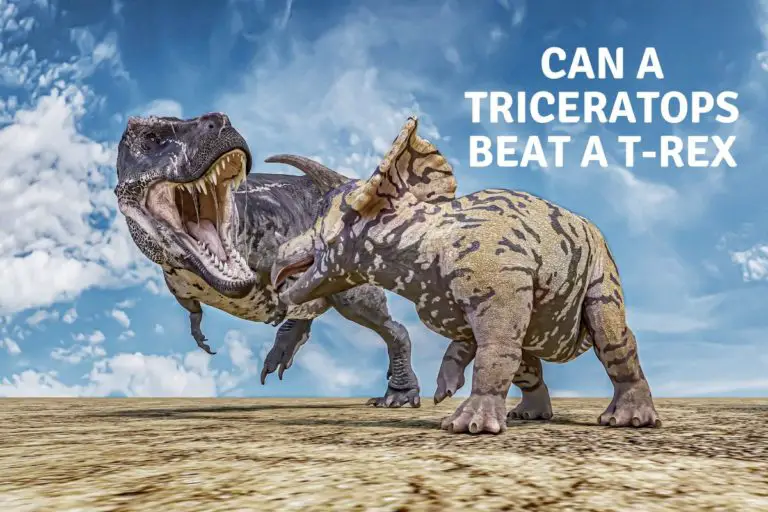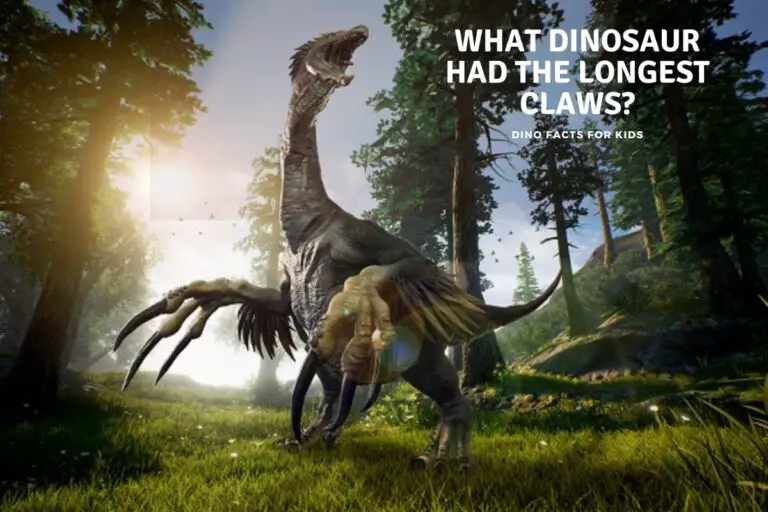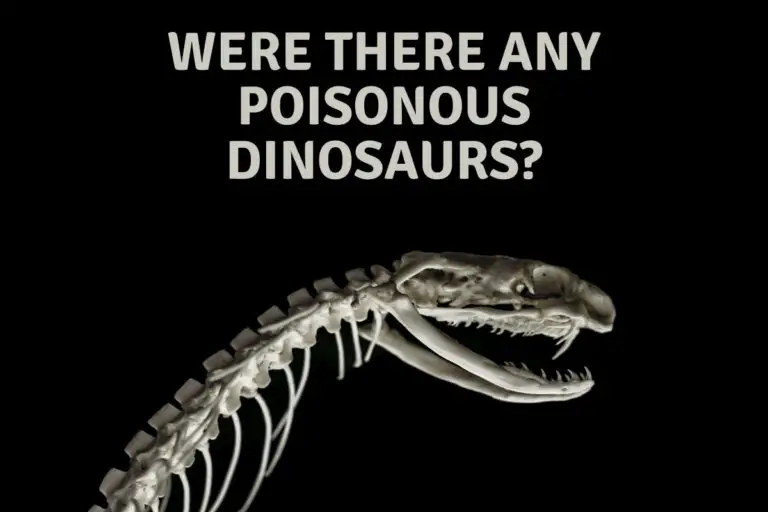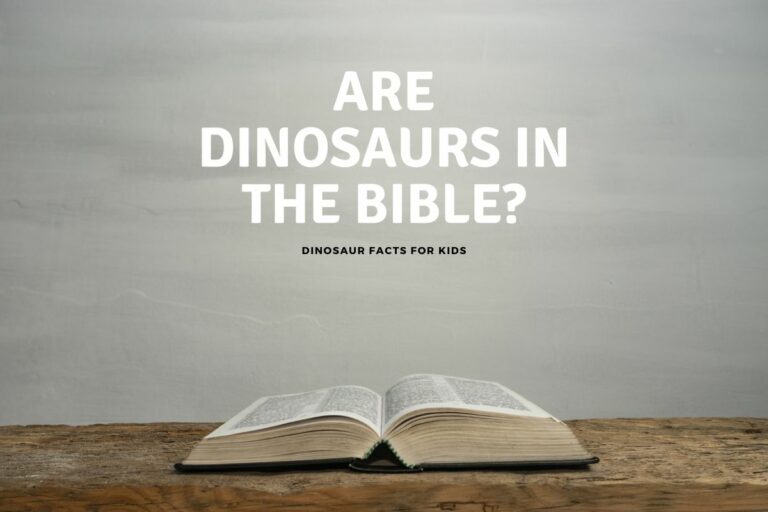How to Find Megalodon Teeth?
The only way we know that the largest shark to ever live actually existed is through its teeth. Shark skeletons are made of cartilage rather than bone and cartilage doesn’t fossilize easily, and neither do teeth, however they do fossilize better than the rest of the shark, and teeth are the most common megalodon fossils found. (occasionally coprolite – poop- and some veterebra)
Megalodon teeth are found by searching high tide marks (strandlines) especially following storms, in eroded cliffs and on the waterline. Look for contrasting colors and larger shapes in the debris left by the tides or use sifters to sieve sand. Searching in areas known for Megalodon teeth the best way to start.
Megalodon teeth are large, as befits the largest shark, but as its extinct they can be harder to find than more recent shark teeth and there are some tips you can follow to make it easier. We take a look at these in the article below.
Be warned your gonna have to get your hands dirty if you want to bag your own megalodon tooth.
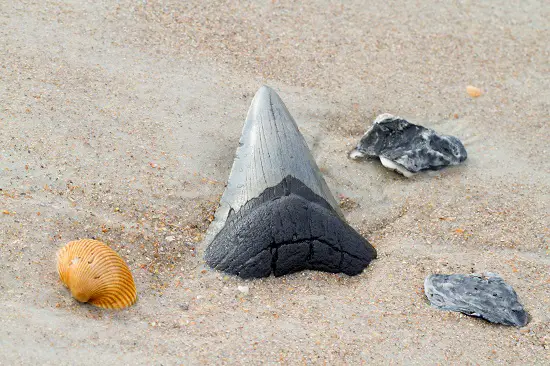
What do Megalodon Teeth Look Like?
Once you find a megalodon tooth it is pretty obvious, They are, like many other sharks, triangle in shape with sharp and serrated edges, and the front of them is often concave and curved.
Although the largest ever found can be over 7 inches long, (17 cm) but these are understandably rare. A much more likely size is 1-3 inches and really good find is anything over 4 inches. Which is still much larger than a great white sharks tooth – the record tooth size for a great white being 2.5 inches long.
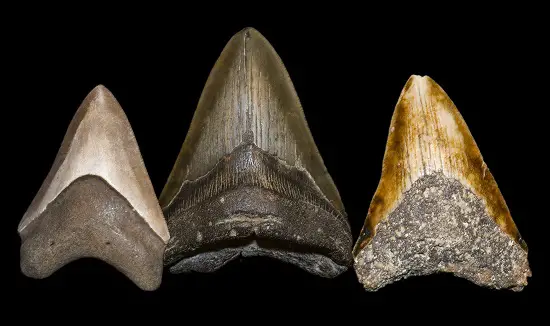
The enamel on a Megs tooth, if it is still present, can be a range of colors, however normally it is a light grey ( like the tooth i own and include an image of here) The root of the tooth if you find a complete one is often a darker color like dark grey, brown or black
If the megalodon tooth is well preserved and not too beaten up the serrations should be still be both visible and still sharp. I actually use mine in class to show by cutting through a cardboard box ( which it does with ease!)
When to look for Megalodon Teeth?
We will take a look at the best time both of day, and of year to start your searches in this section, and by time of day we don’t mean morning or afternoon. the best time is actually at low tide as more of the sea bed is exposed, and it should be easier to see what fossils have been brought in on the previous high tide. so searching along the tide lines systematically will be your best bet here.
Also big storms often churl up both the sea floor ( in shallow waters) and sometimes the cliff faces ( so be careful here!!!) and new areas, or previously fixed in rocks and fossils may be deposited on the beach. It is a great time to look if you can check the low tide the day after a storm! not just for megalodon teeth but for all manner of sharks teeth and fossils.
The only downside of storms is that if you decide to snorkel and look for fossils then the water will be churned up with less visibility directly after so its probably best to stay on shore at these times.
Be aware that some location may have restrictions on times of day or year so check out the rules in your area before you head out
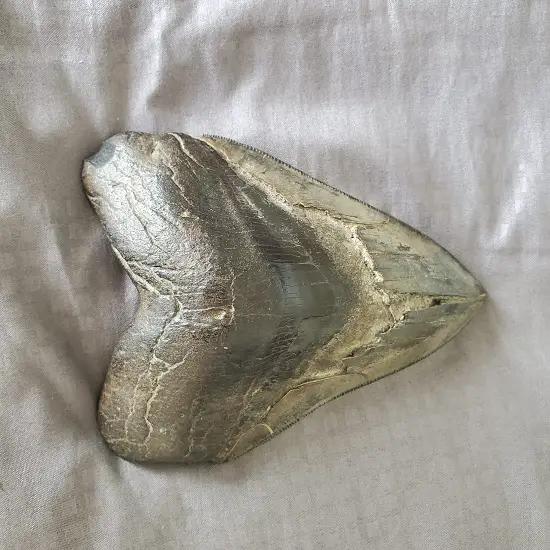
What Equipment Do You Need to Find Megalodon Teeth?
Although you can find Megalodon teeth with a good pair of eyes and just a good pair of walking boots there are affordable tools you can get that will make it both more effective and fun and more enjoyable. We take a look at these below, and a couple of links to where you can buy them.
- Sifter: A mesh sifter will help you sort through sand and sediment to find smaller teeth and other fossils, and has the added bonus of being able to catch any small nugget of precious metals as well!.
- Digging tool: A digging tool such as a trowel or small shovel can help you carefully dig around potential teeth and fossils.
- Fossil Bag: A sturdy bag to collect and safely store any found teeth with some padding if possible in case you find that 7 incher! An old camera bag should suffice.
- Protective gear: Depending on the location, you may need protective gear such as gloves, hat, and sunscreen and if you going into the water then possibly a wetsuit and floatation device.
- Waterproof clothing and footwear: If you are searching in the water, you will need waterproof clothing and footwear to stay dry and you will need to take all precautions necessary
- Magnifying glass or loupe: To examine found objects and confirm if they are indeed Megalodon teeth or fossils.
How to Search for Megalodon Teeth?
There is a little planning needed to successfully search for Meg teeth, and a few techniques you can use to speed you up. we have these split in to the two lists below to give you a head start.
- Do some research: Start by researching popular locations for finding fossils, such as beaches, rivers, and underwater caves, take to other people who do this or join a group as its not only more fun to look with people, its more fun as well.
- Pack your bag: We mentioned some useful tools to help make the search more productive like a sifter, digging tool, and bag to collect found teeth.
- Permits and Rules: Be aware of local laws and regulations regarding the collection of fossils and obtain necessary permits your local government will be able to help you with this, and the clubs or groups if you are part of them.
- Identification skills: Know what Megalodon teeth look like, they are kinda hard to miss being large, triangular in shape and have serrated edges. However meg teeth are not the only things you will find, other sharks teeth and fossils may well turn up and having an idea of what is in the area, as well as what it looks like is really useful. A fossil identification book would be useful we have a couple linked below.
- Patience and persistence: Its a big ocean, and even Megalodon teeth, as big as they are can be tricky and time-consuming so remember to have a little patience and keep going.
- Dress for the conditions: Wear appropriate clothing for the weather, a good set of waterproof boots will make your day much more enjoyable!
Techniques to search for Meg teeth.
If it is your first time looking for fossils on the beach it may feel a little overwhelming, the techniques below will help you, but going with someone more experienced will help you more – at least the first few times.
- Look for new areas: Look for areas where erosion has exposed new areas of the ocean floor, or tidelines this can reveal new Megalodon teeth.
- Know the area: Look for areas known for having fossils, especially after storms or other weather events that can uncover new areas.
- Ask locals: and experts Talk to local experts, including park rangers, beachcombers, and scuba divers to learn about any known locations for Megalodon teeth.
- Systematic searching: Search methodically, working from one area to the next, and covering a wide area. keep a record of where you have searched so you don’t go over your own footsteps
- Strandlines: Look at the bands of rubbish ( unfortunately) and shells that the outgoing tide has brought in, looking for anything a little out of the ordinary. these are areas are called the strandlines and fortunately for your feet it is the more dry area of the tideline.
- Try the water line: If the strandlines are a bust then you can try the waterline ( NOT TOO DEEP, especially if the sea is rough) to see what the new tide is starting to bring in. Remember you are looking for somehtign likely bigger and a different color to the surounding sand and shells
- Use the tools: Wash sand through a sifter to find smaller teeth especially at the low tide area. this is like panning for gold, but usually more successful!
- Snorkeling or diving: Exploring shallow waters, rivers, and beaches to look for Megalodon teeth. — do NOT do this alone and make sure you know the area as it has huge safety issues.
- Join a group: Consider joining a fossil hunting group, as they can provide support, resources, fun and expertise.
Where are Most Megalodon Teeth Found?
Megalodon teeth have been found all over the world, but the largest concentration of fossils is along the East Coast of the United States, particularly in the states of Florida, Venice beach in particular, and South Carolina , blackwater rivers, and Marylands Calvert cliffs state park, which is where mine was found. If you look to buy on line there is a high likelihood you will have a south Carolina tooth in your hands!
Other areas with high concentrations of Megalodon teeth include the Pacific coast of Mexico and Central America, as well as the beaches of Peru and Chile. Megalodon teeth have also been found in Europe, Africa, Australia, and Asia, although the number of fossils found here is much less.
The reason for the concentration of Megalodon teeth along the East Coast of the United States is due to the geology of the area, and at the time was a breeding ground for the Meg and a shallow ocean at the time.
Where on the beach are most Megalodon Teeth found
As we mentioned above in our techniques section. the best place ( if you are one of the first fossil hunters on the beach) too look is just before low tide in the bands of debris and rubbish left on the beach in bands. these bands are called ‘strand lines’ and are fairly noticeable with shells, rocks, pebbles and sadly rubbish forming bands or water marks.
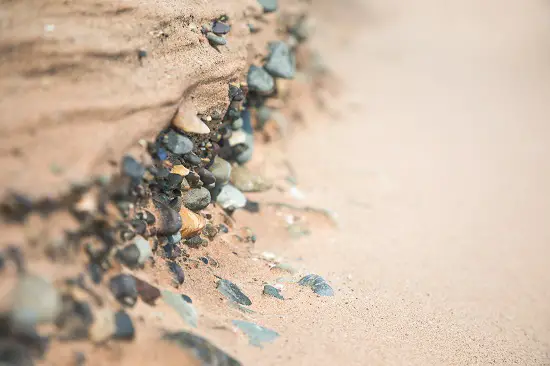
walking along these looking for contrasting colors and larger shapes ( not jsut triangles as teeth get broken after they are out of a mouth too!) is a good way to spot megalodon teeth and other fossils.

then also check the waterline ( carefully!) to see what the income tide is bringing in if you have no luck on the strandlines.
Be Safe When Searching for Megalodon Teeth!!
As with all outdoor activities, and you certainly won’t find Megalodon teeth indoors (well apart from a shop!) you need to be aware of potential hazards when doing them. Fossil hunting in general is a safe activity if you make yourself aware of and safety issues that could occur.
This list below is not exhaustive and we STRONGLY suggest you do this activity with a group.
Tides:
Take a look at the local tide times in your area. We mentioned that you may have more success on a low tide, but this means that high tide is 5-6 hours away and the water is going to be constantly coming in.
if you live in an area with fast tides then you simply won’t be able to outrun these if you get caught on a sandbank or similar. Always keep an eye out on what the sea is doing, and do not stray to far from the group we just recommended you are in. this is doubly important if you are on an area of coast you are not familiar with.
Sharks other marine life:
The Megalodon may have gone extinct 2 or so million year ago but there is plenty else in the sea that can cause you harm. Sharks may or may not be in your area, but there will be rocks, rips, fishermen, boats and all other manner of hazards you may encounter. Seek advice – even if you are only ankle deep in the water.
Cliffs and falling rocks
Storms may bring some cliff erosion, and this will display sections that have not seen the light of day for million of years, potentially exposing fossils, but also creating some risk. If parts of the cliff have slipped or fallen then there may be loose rocks waiting to fall.
Even small ones pose a danger to you so if you are planning on looking at the foot of cliffs, especially but not only after storms, then take head protection and keep our time short.
Temperature
Hypothermia is no joke, i got this in my younger (and thinner) kayaking days and it can come on quick or be a slow burn, be aware of the signs both in yourself and others, ( can check here) and have a warm drink to hand,
Similarly if you are searching for Megalodon teeth in Summer, heat stroke is a risk, take hats, cold drinks, and even beach umbrellas to give you some shade.
Fall hazards
If you are looking near the top of drops and cliffs be aware of fall dangers, and if needed rope up. ( a whole new skill set) Cliffs are inherently unstable especially after storms, and really there is no need to head up there for megalodon teeth in most areas, if you are looking for other fossils, then you will need to protect yourself from falls and this show only ever be done in a team.
Importantly let people know where you are and what time you plan to be back, this can be friends and family but also you can let a lifeguard or even coast guard know where you will be so they know if you don’t report back that you might need assistance ( so don’t be a jerk and let them know you are safe when you get back) and take a simple first aid kit with you in case anything does happen.
accidents are rare, but being aware and planning ahead can help to avoid or deal with them if they occur.
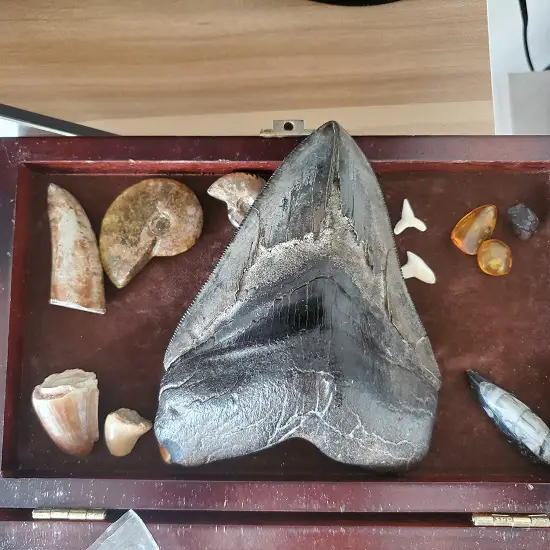
We have a selection of articles on Megalodon and other of the large Marine reptiles here on the site you can check them out in the list below.
- What was the bite force of a Megalodon
- Best Megalodon Movies
- Are Megalodon alive today?
- Where to find Megalodon teeth
- Megalodon Vs. Blue Whale
- How Big was Kronosaurus
- How Big was Mosasaurus
Conclusion
The key thing about searching and finding megalodon teeth is to make sure you do it safely, and then you can focus on the where, when and what you needs.
Looking on a beach known for fossils and sharks teeth is of course your best bet, as is looking all the strandlines, and the high tide lines where larger items should have been stranded, and look for contrasting colors and shapes to beach.
if you want to go further then a sifter and trowel and you can dig down into the sand. a Foot or so should be the equivalent of a few years or more, and see what previous tides have brought in.
Which ever way you decide to go, you will have a lot of fun, and will never forgot that first tooth you find, be it a monster 7 inches, or a little baby 1 inch tooth.
References
- https://www.dutchsharksociety.org/how-to-find-megalodon-teeth-on-the-beach
- https://www.rockseeker.com/where-to-find-megalodon-teeth/
- https://sciencing.com/megalodon-teeth-7373668.html
- https://gardenandgun.com/articles/an-experts-guide-to-finding-shark-teeth/
- https://gardenandgun.com/articles/an-experts-guide-to-finding-shark-teeth/
Hi, I am Roy Ford a General Studies and English Teacher who has taught all over the world. What started as a fossil collection became a great way to teach, motivate and inspire students of all ages and all over the world about dinosaurs and from that and children’s love of dinosaurs came the site dinosaur facts for kids, a resource for all ages.




